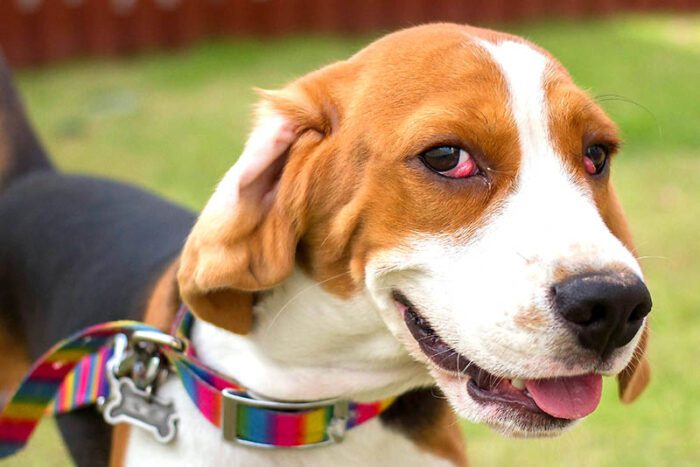Cherry eye is a common condition in dogs where the third eyelid prolapses and becomes visible. While it’s most often seen in Beagles and other breeds with loose skin around the eyes, cherry eye can happen to any dog. As a dog owner, it’s important to recognize the signs of this condition and understand the available treatment options. In this article we talk about Beagle Health Watch-Symptoms and Treatments for Cherry Eye.
Table of Contents
What is Cherry Eye?
Cherry eye refers to a prolapsed gland of the third eyelid. Inside the third eyelid is a tear producing gland, and when this gland pops out and becomes swollen and inflamed, it looks like a red cherry next to the eye – hence the name “cherry eye.” While it may look serious, cherry eye is not usually a painful condition and doesn’t affect vision. However, it can lead to irritation and inflammation and should be treated.
What Causes Cherry Eye in Dogs?
The exact cause of cherry eye isn’t always known. However, it’s believed to be caused by a weakness or malformation in the ligaments that hold the gland of the third eyelid in place. This allows the gland to prolapse and become visible. Certain breeds seem predisposed, implying there may be a genetic component as well.
Factors that may increase the risk of cherry eye include:
- Breed – Beagles, Boston Terriers, Bulldogs, and Cocker Spaniels are more prone to the condition.
- Age – Most cases happen in young dogs under 2 years old.
- Facial structure – Brachycephalic (short-nosed) dogs tend to have more issues with cherry eye due to shallow eye sockets and prominent eyes.
While it can happen to any dog, the condition seems to most commonly affect young Beagles and other breeds with loose facial skin and eyes that bulge out more than normal.
Signs and Symptoms of Cherry Eye
The most obvious sign of cherry eye is the appearance of a swollen red mass protruding from the inner corner of your dog’s eye. The prolapsed gland itself is usually clearly visible as a rubbery, bright red bump on the white portion of the eye.
Additional symptoms can include:
- Swelling around the eye
- Discharge or excessive tearing
- Squinting or apparent irritation in the eye
- Rubbing at the eye with a paw
- Reluctance to open the eye
In most cases, dogs don’t seem bothered by cherry eye and you may just notice the red protrusion while petting or playing with your dog. However, some dogs do appear irritated. It’s important to make an appointment with your vet whenever you notice this condition to prevent secondary issues.
Potential Complications of Cherry Eye
While cherry eye sounds much more serious than it usually is, in some cases complications can develop if left untreated. Potential issues include:
- Ongoing irritation leading to pawing at the eye
- Corneal ulcers from rubbing
- Infection
- Tear production problems leading to dry eye
- Vision problems
To prevent complications, it’s recommended to have your vet assess cherry eye promptly when you notice it. Most dogs do very well with treatment.
Diagnosing Cherry Eye in Dogs
Cherry eye is usually diagnosed simply based on the characteristic appearance of the protruding gland. Your veterinarian will perform an eye exam to rule out other possible eye issues causing redness and swelling, such as infection, injury or glaucoma. They’ll also check for corneal damage from rubbing.
While cherry eye may affect only one eye at first, dogs often develop it in both eyes over time. Your vet will likely recheck the unaffected eye closely on follow up exams. Additional diagnostic tests usually aren’t needed as the protruding gland is quite obvious on exam.
Nonsurgical Treatments for Cherry Eye
In mild cases of cherry eye, vets may try nonsurgical treatments first. These include:
Anti-inflammatory medication
Eye drops or ointments containing corticosteroids may help reduce swelling and inflammation. However, medication on its own often doesn’t resolve the gland prolapse.
Antibiotic ointment
If infection or corneal ulceration is present, antibiotic ointment may be prescribed.
These nonsurgical options may be temporary fixes but many dogs require surgery for a permanent cherry eye cure.
Surgical Treatments for Cherry Eye

Surgery is the treatment of choice for most cases of cherry eye in dogs. Two main surgical options may be recommended:
Pocket technique
This method involves creating a pocket or anchor for the gland so it can be repositioned back behind the third eyelid. The pocket holds the gland in place to prevent further prolapse. Success rates are around 90% with this approach.
Gland removal
If the protruding gland is too swollen, the pocket technique may not be possible. In these cases, the gland itself is removed. This prevents it from popping out again. While tear production may be slightly altered, most dogs have no long term issues.
Both surgical procedures are fairly quick and straightforward. Dogs are generally placed under anesthesia so no discomfort is felt during the short surgery.
Recovery and Aftercare
Following cherry eye correction surgery, dogs require medication and restricted activity to support healing:
- E-collar – An Elizabethan collar is essential to prevent pawing at the eye. The collar must be worn at all times for 1-2 weeks.
- Eye drops – Antibiotic and anti-inflammatory drops are typically prescribed for 5-7 days after surgery.
- Exercise restriction – For the first 7-10 days post-surgery, exercise should be limited to short leash walks. No running, jumping or rough play should be allowed during the initial healing period.
- Rechecks – Your vet will want to examine your dog’s eye closely within 5-7 days to ensure proper healing after cherry eye surgery. Additional rechecks may be recommended.
Proper aftercare greatly impacts the success rate of cherry eye surgery. Following your vet’s recovery instructions closely gives your dog the best chance of getting back to normal as quickly as possible.
Can Cherry Eye Return After Surgery?
In most cases, surgical treatment for cherry eye eliminates the gland prolapse permanently. However, a small percentage of dogs may experience recurrence:
- After pocket technique surgery, recurrence rates are around 10%.
- If the gland itself has been completely removed, recurrence is very unlikely but not impossible.
If cherry eye reappears after surgery, a second procedure may be recommended. The initial surgery often makes the area of weaker tissue that allowed prolapse easier to identify and repair. Success rates for the second surgery are excellent.
With proper surgical treatment and follow up care, the vast majority of dogs have an excellent outcome and no further issues with cherry eye after recovery. Recurrence usually happens shortly after surgery rather than months or years later.
Are There Any Home Remedies?
While you may find suggestions for home treatments like cool compresses and herbal remedies online, there is no evidence that these actually resolve cherry eye effectively. The protruded gland itself must be repositioned or removed to provide a lasting cure.
As some dogs seem bothered by cherry eye while others barely notice it, you may try soothing the eye by:
- Gently wiping the area with a clean, damp cloth
- Applying a cool compress for 5-10 minutes several times a day
- Keeping hair trimmed around the eye to prevent irritation
However, surgery gives the best results and prevents recurrence. Home care can provide some relief but veterinary treatment is still required for cherry eye.
When to See the Vet
Make an appointment with your veterinarian as soon as you notice the red, swollen gland protruding from your dog’s eye. While an urgent same or next day visit usually isn’t necessary, cherry eye should be evaluated within the next few days.
See the vet promptly if your dog seems painful, the eye appears very swollen or inflamed, or vision seems impaired. These signs may indicate a secondary issue requiring quicker treatment.
Catching cherry eye early and pursuing appropriate surgical correction prevents complications down the road. Supporting your dog through an initial short surgery and recovery period is much easier than dealing with chronic eye problems later on.
Prevention of Cherry Eye
While you can’t guarantee cherry eye won’t happen, keeping your dog’s eyes clean and healthy may reduce irritation to the area. Try these prevention tips:
- Gently wipe eyes daily to remove any discharge
- Trim hair around the eyes so it doesn’t poke into eyes
- Use doggie eye wipes to keep the area clean
- Avoid rubbing or putting pressure on eyes
- See your vet about supplements that support eye health
For breeds prone to cherry eye, be alert for any redness or swelling near the eyes. Catching changes early allows for quicker treatment.
Cherry Eye Outlook
When addressed quickly, most dogs have very positive outcomes after surgical correction of cherry eye. With proper treatment, including surgical options like the pocket technique or gland removal, dogs typically recover well. Aftercare involving medication, restricted activity, and regular vet check-ups is crucial to ensure proper healing and minimize the risk of recurrence. Early detection and prompt veterinary care are key in managing cherry eye effectively and preventing potential complications such as corneal ulcers or chronic irritation. I sincerely hope you find this “Beagle Health Watch-Symptoms and Treatments for Cherry Eye” article helpful.


